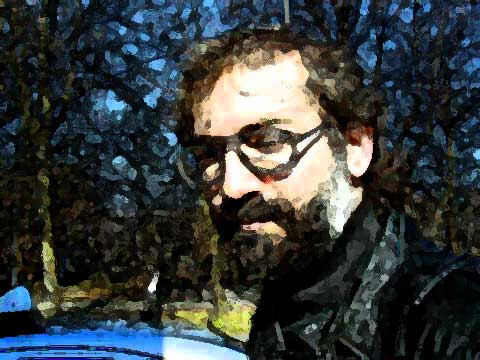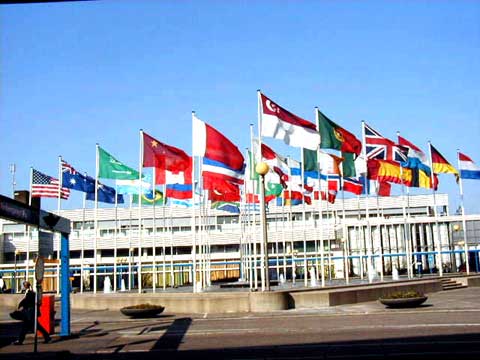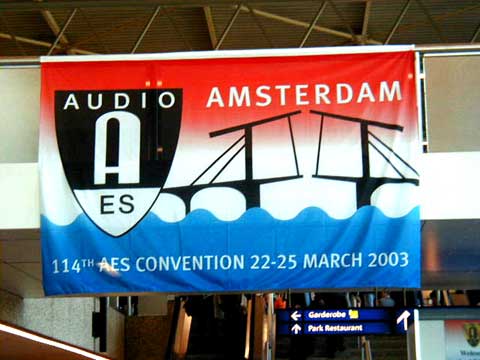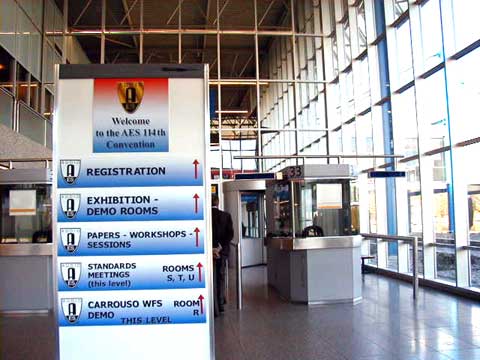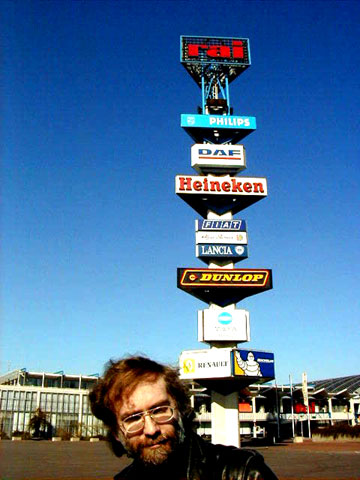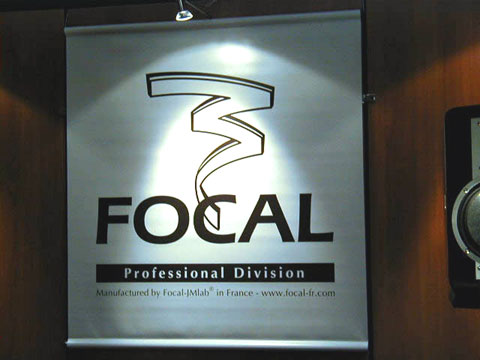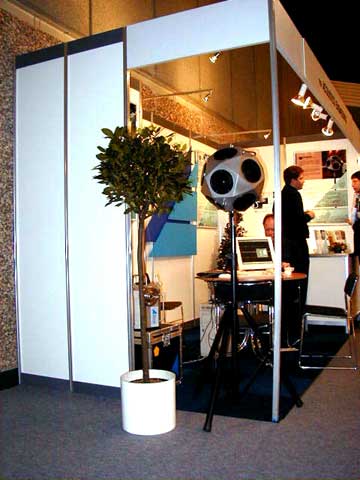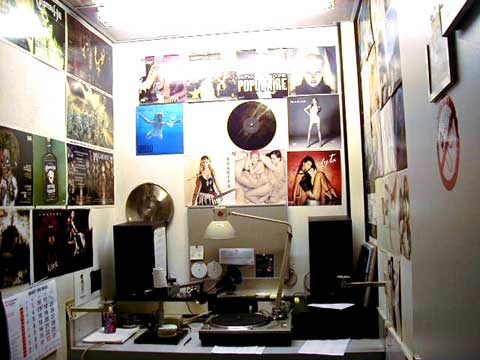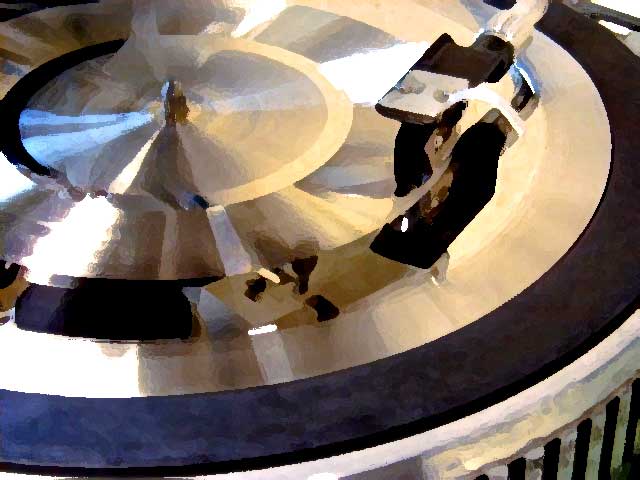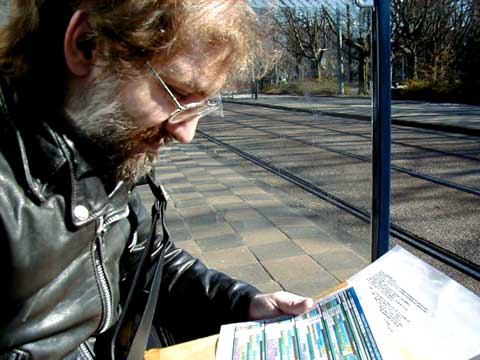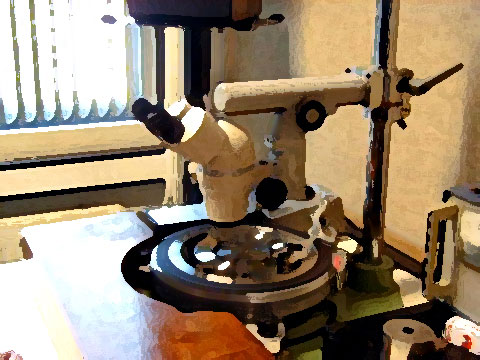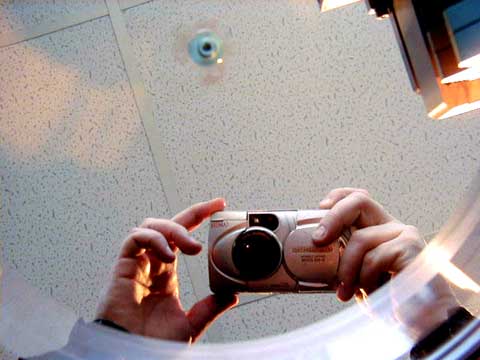|
You are reading the older HTML site
Positive Feedback ISSUE 6 Critical Reception: The 2003 AES Show in Amsterdam
(Photographs by Melissa McDowell; image processing and artistic enhancements by David W. Robinson) The spring AES show this year was held in Amsterdam, and what with one thing or another and the outrageously cheap airline rates due to the war, I couldn't help but attend. When we think of Holland, we think of tulips, windmills, wooden shoes, and tacky marital aids, but I was pleased to find that Holland was an excellent place for an audio show as well.
It's always very interesting for me to write about what is basically a pro audio show from a high-end audio viewpoint. I'm going to try to concentrate on higher end products and on papers that might affect the high end community, but here and there I'll probably mention some lower grade stuff that I just found personally interesting. Most of this discussion is pretty cursory since the show really was so large and there were so many things going on, so please pardon me if the level of detail here is a bit weak. There were a lot of papers at the show, with a continuing emphasis on multichannel imaging, class-D amplifiers, and perceptual encoding. There were also a lot of papers this year on intelligibility concerns in various communications systems. I just summarize here a few of the papers that I attended, found interesting, or that I think high-end audio folks would find interesting. This is a tiny sampling of the huge number of actual presentations.
The show itself was extremely quiet, with fewer loud and flashy displays on the trade show floor, and a lot more substance in actual demos. You could actually talk to people on the show floor because things were at a much more leisurely pace than the American shows. A lot of American companies pulled out; Harman International refused to send any American representatives and even small outfits like Millennia Media and XXX declined to send folks from the US offices. THAT corporation, manufacturer of very fine microelectronics for high-grade audio, had a booth that remained totally empty with the plastic covers never removed from the furniture since nobody showed up. DSD and SACD This was definitely the show for DSD, which seemed to be all the rage this year. Genex was showing off eight-channel D/A and A/D converters that could handle 24 bit 192 Ksamp/sec PCM as well as DSD, and 8 and 48 channel DSD recorders. This is the basic gear needed for full DSD recording work, and it needs to become more inexpensive and plentiful before we get a good body of recordings available in that format for SACD release. Prism Sound was also showing the ADA-8 8-channel converter with a new DSD option which allows direct conversion from analogue to DSD and additional all-digital conversion between DSD and high-rate PCM signals. This is not only a useful recording tool for DSD recordings, but it's also a useful tool to help figure out how much of a sonic improvement DSD actually buys you in a given situation, and that is an important thing that I don't think anybody really knows. This can be as much a learning tool for getting a sense of what DSD will mean to us as anything else. "It's a bloody aardvark" — Blackadder (as seen at Digidesign booth) Meanwhile, Derk Reefman from Philips was talking about some research there on constructing multi-bit D/A converters for DSD data. A New Digital-to- Analogue converter design technique for HiFi applications goes into their "Dynamic Element Matching" technique for improving linearity. Because the converter is not purely one-bit, it can operate at lower rates and be more immune to jitter. Preprint #5846.
High Resolution PCM Digital Stuff High resolution recording was all the rage, and what really excites me about this stuff is not the possibility for better sound quality with high resolution release formats, but the possibility for processing in the digital domain that actually sounds clean. Fostex was showing the DV40, a machine that could record up to four audio tracks at up to 24 bit/ 192 Ksamp/sec resolution onto a DVD-R disc in the studio, and the PD-6, a portable machine that could record up to six audio tracks on the same media. Nagra was showing the Nagra-V, a two-channel PCM recorder that can record up to 24 bit 96 Ksamp/sec data onto Orb cartridges or onto small removable hard disks. It stores data directly in a PC file system format as broadcast .WAV files, allowing the disks to be directly loaded into an editing workstation, and it has converters designed by folks who have good ears. They were also showing off a lovely little four channel mixer that fits into the palm of your hand and has a clean digital output, which would be the perfect solution for field recording engineers using older DAT machines who need a better front end and some limited mixing as well. Unfortunately they had only a prototype on display and had no real information about the product yet. Juenger was showing off a line of very high grade digital processing gear. What was most interesting wasn't the usual gear like the digital dynamics processors and high grade digital equalizers, which are seen in a lot of mastering houses in the US and which are some of the cleanest- sounding devices around. What I found interesting were things like the radio broadcast processing devices (all much too expensive and too aimed at high quality sound for American broadcasters), and things like their tiny four-input digital desktop mixer. They also had a modular DSP system. This is minimalist processing gear that is intended to pass data changed as little as possible and have as little impact on sound as possible — the sort of thing I'd like to see more of but which won't sell well in the US because of a lack of flashing lights and gadgets. Weiss also had a booth, and if you think you haven't heard the Weiss converters and equalizers, you have been listening to the wrong records. The Weiss digital EQ is probably the best I have ever heard and their converters are amazing. But they also showed off a lot of gear that I have never seen in any mastering house in the US: dynamics processors, sample rate converters, even a re-clocking and de-jittering box called the Hydra-C which addresses a real problem in large digital plants but may also have some serious applications in high-grade home systems. Not to mention their usual DAC-1 D/A converter which is one of the most linear I have heard any any cost. Weiss does also have some very impressive high-end home gear too, although sadly they didn't have any of it on display at this show. In a somewhat lower budget converter range, Sonifex was showing their RB-ADDA combined A/D and D/A, 24 bit 96 Ksamp/sec, along with a sample rate converter, a DAC-only box, and a digital splitter/combiner box for compatibility with some older gear that uses 2 connectors for a single high-resolution pair. They also had a few handy analogue gadgets like limiters, mike preamps, and distribution amps. Mutec has a whole line of handy conversion and clocking gadgets. Their Multichannel-AT device is both a sample rate converter and also can convert between ADAT and T-DIF multichannel digital interfaces. Their WS box is a clock distributor, to help you take a single master clock and distribute it to multiple destinations around a studio, and they also make a variety of master clock devices (some of which also provide clock synchronization to an internal video master clock, so one box can provide blackburst for video synch as well as master audio synch in a complex video system). All of this clock hardware is capable of operating at some outrageously high clock rates, well beyond 192 KHz. The DVD-A consortium was there too, handing out some handy little pamphlets from Dolby on DVD-A, as well as catalogues listing all the current DVD-A releases. It made me think of the early days of CD, when the CD was such a small part of the market. I was really surprised at some of the stuff being released on high resolution formats. The Toots and the Maytals disc sounded good too. Even some more pedestrian manufacturers were heavily into the whole high resolution digital movement. Inter-M, a Korean manufacturer known in Asia for everything from large-scale mixing consoles down, is hardly ever seen on American shores. They were showing first of all the MEQ-2000 equalizer unit, with 24 bit, 96 Ksamp/sec inputs and outputs and a variety of user interfaces that would allow it to behave like a parametric or graphic EQ. They also had the MXO-2000 loudspeaker crossover, which again operated entirely in the digital domain at 24 bit 96 Ksamp/sec. It looks like a lower cost alternative to some of the higher-cost speaker management systems like the BSS Omnidrive, and the nice thing about the digital world is that if the software is implemented well and good outboard converters are used, it could sound very good at low cost. Inter-M was talking about improved American distribution but they were going to bring in the digital products first, then worry about the rest of the line (like consoles, amplifiers, and speakers). Z-Sys was also showing their very clean 5.1 mastering processor, with six channels of digital EQ and dynamics processing at high resolution rates. In addition, they had a low cost two-channel digital EQ unit, with digital inputs and outputs only and no converters. Sadly nobody there seemed to really know the products or the line, however. Out on the conference rooms, Akira Nishimura and Nobuo Koizumi from the Tokyo University of Information Sciences were discussing Measurement of sampling jitter using a musical signal. That's right, they were showing a method for detecting sampling jitter in a DAC or ADC using a musical signal rather than a test tone, something that has utility in determining just how useful current jitter measurement standards are. Preprint #5797. 1-Bit Converters Because of the huge amount of work going into DSD systems right now, there has been a lot of work being done in the field of 1-bit converters. Most of this data applies equally well to DSD and to PCM high resolution conversion systems, and there have been a huge number of researchers working on the theory behind converter designs which can be used for both. Ever wonder where those idle tones in sigma-delta converters (like the Yamaha Bitstream) come from? Ever wonder how modern sigma-delta systems manage to reduce them? Ever wonder about the tradeoffs in doing so? J.D. Reiss and M.B. Sandler from the Universit of London gave a great talk called They Exist: Limit Cycles in High Order Sigma Delta Modulators. You can read about it in Preprint #5832 if you are curious about the math. Bruno Putzeys from the Philips Digital System Labs gave a talk from a more applied perspective, under the title Design techniques for high-performance discrete A/D converters which gives some overview on 1-bit converters using direct modulation and the various design constraints at each stage of the circuit. Preprint #5823 and interesting if you are at all curious about converter design. Last year at the AES show in Munich, Hiroshi Kato gave a talk on trellis encoding, which makes one-bit converters more linear than those built with conventional sigma-delta types. Two papers at the show this year built on that data with discussions on trellis-encoded converters. Pieter Harpe from the University of Technology in Eindhoven, along with some engineer from Philips, talked about an Efficient Trellis-type Sigma Delta Modulator (preprint #5845) while James Angus from the University of Salford talked about Tree-Based Lookahead Sigma-Delta Modulators (Preprint #5825). An interesting look at a still-nascent technology.
Other Surround Stuff I have to admit that I have always thought techniques to generate full stereo images from individual elements have always been a bit gimmicky, but Ambio is selling something called the Diesel system which is able to generate surprisingly convincing images over pretty poor playback systems. Not suitable for the high end, but certainly something that has a lot of market in the multimedia industry. More interesting from a home hi-fi perspective, they are showing off a system called Ambio which is able to develop a surprisingly accurate image from a conventional stereo or 5.1 recording, over a pair of headphones, by using a room simulation and a head-transfer-function simulation. Not as impressive as the real thing, but a huge improvement when you are in situations where you are forced to use headphones. Slawomir Zelinsky at the Institute of Sound Recording at the University of Surrey, along with some folks from Bang and Olafson, did some subjective listening tests of surround systems to see how audible bandlimiting and different algorithms for down-mixing from 5.1 to various speaker systems sound. Their paper, Comparison of Quality Degradation Effects Caused by Limitation of Bandwidth and by Down-mix Algorithms in Consumer Multichannel Audio Delivery Systems is preprint #5802. Robin Miller from Filmmaker Studios talked about down-mixing Ambisonic and modified Ambisonic recordings made with both the Ambisonic microphone array and with additional external microphones, into standard 5.1 and 6.1 surround configurations, in Transforming Ambiophonic + Ambisonic 3D Surround Sound to & from ITU 5.1/6.1. Preprint #5799. There were a lot of papers on extremely multichannel audio systems, but the only one I found truly interesting was a demo from the Carousso Project, an EU funded group which is trying to achieve better recreation of original sound performances, using computer models of rooms, combined with extremely large speaker arrays. There was a paper on the subject by Ritta Vaananen called User Interaction and Authoring of 3D Sound Scenes in the Carrouso EU Project (Preprint #5764), and another from Beate Klehs and Thomas Sporer called Wave Field Synthesis in the Real World: Part 1 — in the Living Room (Preprint #5727), but what was most interesting was something that can't be described in a paper: the actual demonstration of the system playing back a number of source recordings using a large circular array of speakers. The system was not terribly natural sounding but the sense of space was far better than I have heard in any multichannel array, and the system generated a huge amount of discussion at the show with people quite polarized on the various imaging issues. Arnod Laborie from the Immersive Sound Project in Paris was talking about similar systems using large arrays of condenser microphones in A New Comprehensive Approach of Surround Sound Recording, preprint #5717, while Edo Hulsebos and friends from the Delft University of Technology were using a circular array with 288 microphone capsules mixed down to 24 channels which are processed to 12 channels for playback, in Circular microphone array for discrete multichannel audio recording, Preprint #5716. Mixers Tamura, a Japanese company known in the US mostly for manufacturing audio transformers, is also apparently a large manufacturer of audio gear that never gets seen much outside of Japan. Their latest gadget is a small 8 channel digital field production mixer that can run off DC power. It's in a funny sort of market niche because it's larger than most film and video field mixers, but it's clearly intended for field production work. It's called the izm 125. Tamura was also showing off a variety of smaller analogue field production mixers, again devices that have never been seen on American shores but which look quite compact and impressive. D&R was showing off their line of consoles, and I have to say that this is a pretty impressively complete range. D&R used to sell some recording consoles like the Dayner and Cinemix in the US but according to the president, Mary de Rijk, they pulled out of the market in great part because they couldn't compete with the huge influx of low-end gear in the American market and the difficulty of supporting the American users. But they do still still in Europe and what they sell is impressive. First of all, they still sell the Cinemix, which is one of the nicest and most convenient large-format consoles I have ever used. But they also sell a a smaller console series called the Vision, which is probably the smallest fully modular console I know of today. It can be configured anywhere from a 12->2 console, or an 8->8->2 console all the way up to a 44->2 console depending on the frame and modules you get. It can be set up as a side-by side recording console or as a flat PA consoles. Matrix modules are available for multiple monitor sends. It's really a slick little package and it is fully modular with all ICs socketed, and very high grade construction. Then they make a small radio production mixer, the Airmate, and a little DJ mixer, the Clubmate, both much higher grade than you would expect from comparable gear in the American market. They make a huge digitally-controlled analogue console, the Octagon, and a whole variety of digital broadcasting console systems (the Sirius and Scorpius on-air mixers, and a slick little digital production mixer called the Lyra which is compact, clean, and quite minimalist and might have uses for classical recording work). They even make some processing gear like a compressor/limiter, outboard mike preamp, and a telephone hybrid, as well as a high resolution A/D and D/A box. You'll never see this sort of stuff in the US because it's just too expensive for a market that doesn't want to pay for this grade of construction and sound quality. Representatives from an American mixer manufacturer went out to a coffeehouse one night, and fell into a canal in their semicoherent state. They were up bright and early to demonstrate products the next morning, however. Cables Not much in the way of interesting cabling this year. The usual folks at Belden had a booth and I was interested to note that their European catalogue is a bit different than their American catalogue. Going to Europe, one thing that always amazes me is how tiny all of the power cabling is. At twice the voltage, cables can be much smaller to provide the same power. This is combined with a fascination for fine stranding and high flexibility, even in cheap lamp cords. A lot of high flexibility cabling that is considered exotica here in the US is considered standard off the shelf material there, and since I have an obsession with fine stranding for speaker cables, I find a lot of the European power cables make excellent-sounding speaker lines, much better than the American stuff does. Reference Laboratory from Osimo, Italy was showing off some much higher-end materials, and while the translation of their literature was fairly poor it was clear that a lot of careful engineering as well as careful listening went into their cables. They make a variety of cables from inexpensive to quite pricey, and not only do they make the normal instrument (unbalanced line) cables, balanced line, and balanced microphone cables in a variety of configurations, they also make some very impressive speaker cables and also some odd exotica (like audio pairs with accompanying power cabling in the same jacket-- which could be very useful for speaker cables with a feedback pair to the amp). Their general manager, Angelo Tordini was at the show and he gave me the impression that they are truly trying to bring the high end cable ethos into the pro audio world. I have asked for some of their materials to audition. Long-time readers will know that I am a huge fan of the Speakon speaker connectors. These things are becoming increasingly popular in the pro audio world, even if they still haven't made it yet in the high-end audio community. These are large connectors with huge surface area and wiping contacts for good connection, much more reliable than five-way binding posts, and which give you four poles with a single connection to make bi-amping and bi-wiring much more convenient. Neutrik is now introducing the STX, a metal-housing version of the connector which will be even more rugged and which will feature oversized solder lugs for easy connection even to very large speaker cables. Link Corporation was showing off LK multi-pin connectors and Eurocable brand cabling, but all the documentation they gave me was on CD-ROM that I can't read, so I can't tell you anything about what they had on display.
Speakers Before I talk about the speaker systems I have seen at the show, let me talk about the two very disparate markets for speakers in the pro audio world. First of all we have sound reinforcement speakers, intended for high levels in large rooms, often with very controlled dispersion in order to deal with poor room acoustics, and often at the expense of sound quality. Then we have monitor speakers intended for mixing music on in studios and mastering rooms, and they vary all over the map from very high-grade systems that rival anything in the high-end world down to nasty sounding junk you wouldn't want in your house. But one thing they do tend to have in common now is that most of them incorporate their own power amplifiers, so that the speaker and the amp can be matched carefully together by the manufacturer (and of course to eliminate any speaker cable issues). As always, most of the products being made in each category are pretty awful, and a few are wonderful. I'll try and talk about the standouts. Fostex was showing their NF series of powered nearfield monitors. Inexpensive, but fairly clean sounding, they have a soft dome tweeter that is reasonably smooth, and an odd-looking ‘wrinkled' woofer that is intended to minimize break-up modes. It's good to see Fostex getting into the monitor market again after many years out of it, even if they are getting in with only small nearfields. If you have read my show reports for the past six or seven years, you will recall I am a huge fan of the Stage Accompany speakers. Stage Accompany is still around although they have just reorganized, and they are coming out with a new set of ribbon-tweeter based speakers intended for very high-grade sound reinforcement applications. Unfortunately they will be keeping the same American importer, which has been a real problem as far as actually getting SA products in the US. Roland de Groot was representing them at the show, though, and he seemed to really care about trying to get better promotion and distribution in the US so there may be some hope yet. As part of the reorganization, though, a lot of the engineering and marketing folks have left SA and gone to work for Alcons, a company formed by a former SA principal which will also be making a large high-power ribbon tweeter, the RNB601, and incorporating it in a variety of speaker systems. They are also talking about making smaller ribbon tweeters for high-end home and studio monitoring applications. Tom Back, their managing director, seemed downright enthusiastic about markets for the smaller drivers. This now brings the list of companies making high-end ribbon tweeters for sound reinforcement systems up to three: SLS in America, and Alcons and Stage Accompany in Holland. I am very pleased to see this becoming more and more popular since it's a very good way to get controlled dispersion and very flat treble and upper midrange. Certainly much better than horn arrays which have been plaguing PA systems for ages.
Our good friends at Linn are getting into the high end monitor system market at well, with their 328A powered monitor system. This is four way active system with two large servo-controlled bass drivers, and midrange and tweeter domes. In a quick demo, I found it sounded very clear, if not a little bit exaggerated on top, but it was definitely a promising device that I'd like to hear more of. Brian Morris at Linn was a fascinating person to talk with, who seem to be trying to keep a foot in each of the high end and pro audio camps. Focal was showing off some very strange-looking powered monitors with internal D/A converters so that you can plug a digital input directly into them. Three-way systems with passive radiators on the side, they had a very detailed top end without being spitty at all, and a very deep image. Maybe too deep an image, but with a very wide sweet spot. Again another product definitely worth listening to. I know of Focal as a manufacturer of high-end speaker drivers but they have apparently been making full loudspeakers for some time without showing them in the US at all. Musikelectronic Gethein was showing some active studio monitors with odd designs; two-way systems with treble drivers mounted in front of the woofer like a coaxial system, but with soft dome tweeters. These folks are using acoustic delay lines in order to get low end directionality our of their woofer and they are doing an excellent job because the off-axis response is surprisingly flat and as a consequence the sweet spot is very wide. Very smooth and detailed top end without being harsh in any way, and a very clean low end without being flabby. Very characteristically German in their overall feeling, solid and understated. I liked the top end RL901K speaker best, but even their smaller systems were very musical and pleasant to listen to. Panphonics was showing a flat speaker intended for use in breakup mode, sort of like the NXT drivers that I have written about here in the past. Not great phase coherency, but certainly a nifty trick and something that might have higher grade applications someday. One of the nice things about the show has been the absence of the big sound reinforcement speaker companies, and the fact that the folks who have showed up have not been doing demos. In general, the show floor is much, much quieter than at the American shows. You can talk to people on the show floor. It's amazing. In the conference rooms, there were a lot of loudspeaker presentations this year. John Stewart from Harman/Becker talked about "Detection and Diagnoses of Subharmonic Tones Generated in Woofers." He described a weird distortion mode where tones near the resonant frequency of a woofer would create sub-harmonics an octave below that point, and while he didn't talk too much about the actual break-up mode itself, he did talk a lot about the methods used to track it down and detect it. This is another potential source for low-end distortion that has not previously been investigated much. Preprint #5741 summarizes it. Yashuge Nakayama from NHK was talking about A method of 3-D sound image localization using loudspeaker arrays. This turned out not be at all the paper I had expected from the title. Instead, it was a discussion of planar speaker arrays made up of multiple drivers each driven with some delay in order to model either a local or distant point source. Stereo recordings could be played with varying settings in order to change the perceived depth of the stereo image. If you're curious about the configuration, check out Preprint #5793. I was in a porno shop on Ferindand Bolstraat and a man came in and asked if amyl nitrate was legal there. The man behind the counter said that no, it wasn't legal, but that they had three kinds in stock. Using conventional equalizers to compensate for room problems invariably causes far worse problems than it solves. A generation of audio systems suffered horribly from misuse of equalization. But Poju Antsalu and friends from the Helsinki University of Technology and Genelec have investigated a number of impulse response equalization systems. In their paper, Comparison of Modal Equalizers Design Methods they show some limited cases where low end room problems can be helped by signal processing systems that actually adjust the system impulse response rather than crudely adjusting frequency response. They show real numbers and results of subjective listening tests as well. Preprint #5844. Wolfgang Klippel gave some discussion of Nonlinear Modeling of the Heat Transfer in Loudspeakers, talking about voice coil heating and cooling and the total heat budget of the system. It's been ages since I took Thermo and I didn't follow the discussion well enough to summarize it so you will have to read preprint #5733 if you are curious about heating effects in driver design. Richard Small from Harman/Becker talked about Measurement of Loudspeaker Amplitude Modulation Distortion. It was sad and depressing because although his discussion of measurement methodology was very interesting, his actual numbers just helped show how inaccurate even the best speakers really are. I'm a big fan of measuring things to correlate measurements with listening tests, and this is another case where new measurements just help quantify audible effects. Preprint #5731. In Analysis of a Folded Horn, Andrew Bright from Nokia did a finite element analysis of a folded horn design and compared the results of his FEM simulation with actual measurements to show the fidelity of his model and then went on to describe how it could be used to gain insight into how a folded horn actually works. He then proceeded to show the degenerate case where a simple folded horn behaves more like a vented box than a traditional horn-loaded system. Preprint #5745. A more general discussion of finite element models can be found in Finite element methods and equivalent electrical models for loudspeaker characterization, where Guillaume Pellerin, et al., discuss the fundamentals of how to make sure a finite element speaker model is faithful and how general purpose models of drivers can be built. Preprint #5743. What happens if you build a loudspeaker with oversized magnets for much stronger magnetic fields, and greater coupling between the magnet and voice coil? In Direct-Radiator Loudspeaker Systems with High-Bl, John Vanderkooy from the University of Waterloo, Paul Boers and Ronald Aarts from the Philips Research, all figure out that the increased system efficiency and higher damping allow the effects of the box to be felt at frequencies well below the normal cutoff from the driver resonance. This allows a very small box volume to be used along with some low end equalization although it also means a very highly damped box is needed in a vented system. For more details check out preprint #5742. If you build a high order, very sharp active crossover, you can reduce the overlap region where multiple speaker drivers are interfering with one another, but in the process you are also adding more phase shift, so the interference over that narrow band of frequencies is less controllable. Brancon Cohenour, Carlos Chai, and David A. Rich from Lafayette College discuss the issues in Sensitivity of High Order Loudspeaker Crossover Networks with All-Pass Response, preprint #5729.
Listening Tests David Clark from DLC Design in Michigan talked on Listening Technology for Automotive Sound Systems. Now, don't run away just after seeing that title, since this is a very well-done presentation on how to conduct subjective listening tests. In this case he's talking about listening tests of car audio systems, but in fact the methodology he describes can apply to a wide variety of different listening situations. Preprint #5723. There was less work being described on binaural recording and simulation of binaural effects from discrete sound sources than in previous years, but Jean-Marie Pernaux from France Telecom was talking about subjective evaluation of imaging quality through various algorithms used to synthesize artificial binaural recordings from discrete sources. Perceptual Evaluation of Binaural Sound Synthesis: The Problem of Reporting Localization Judgments is interesting if only for the discussion of the difficulties involved in conducting accurate and repeatable subjective listening tests of imaging effects. Preprint #5789. Carl Hetherington and Anthony I. Tew from the University of York talked about measuring the shape of human ears and using individual ears to generate custom models of head-related transfer functions, so that simulated binaural material can be individually customized for each person's personal ears. Parameterizing human pinna shape for the estimation of head-related transfer functions is Preprint #5753. Sean Olive talked about Differences in Performance and Preference of Trained versus Untrained Listeners in Loudspeaker Tests: A Case Study. He found significant differences between different groups of listeners, both in that trained listeners were more consistent and had better reliability from one test to the next, but that loudspeaker preferences were generally consistent among all groups of listeners. From this he concludes that the preferences of a group of trained listeners with higher reliability can be extrapolated to a larger population of untrained listeners. He also shows that in general the speakers subjectively rated the best tend to be those with the flattest measurable frequency response across the plane. Give this paper to people who claim that untrained listeners are fine for listening tests, or that tests with trained listeners aren't significant. Preprint #5728. Gordana Kovacic and Hrvoje Domitrovic talked about the Accuracy of the Listener's Estimation of the Speakers' Body Weight and Height Based Solely on the Voice Signal, showing that most listeners were totally incorrect when asked to estimate what a person's body was like after hearing their voice. They were completely misled by "vocal stereotypes about physical characteristics" which are in great part incorrect. I suppose it's audio related, and it was another example of how sounds can be illusive. Preprint #5726. A group of folks from the Helsinki University of Technology and Nokia, headed by Toni Hirvonen, gave a presentation on Listening Test Methodology for Headphone Evaluation. They let people listen to headphones of various types with different voicing, and to dummy head recordings made of the same sources, and tried to correlate the subjective impressions with diffuse field responses of the headphones and got no real correlation showing that some other factor is affecting it (such as individual head shapes causing differences in response that are specific to individuals). Preprint #5736.
Microphones Microtech Gefell (the former East German Neumann company) had a few new and exciting things to show off. Their new KEM 970 "Cardioid Plane Microphone" is a small line array of small diaphragm condenser capsules to form a microphone with a cardioid pattern in one plane and a much flatter pattern in the other. Very good for mounting in front of stages or choirs where you want a wide pickup pattern but not a tall one, for reduced ambience and (in PA applications) reduced feedback. They were also showing the INA5 microphone bracket system, for mounting five cardioid microphones in a single array for direct surround recording of live sources, along with their usual line of well-made microphones. Pearl and Milab, both companies derived from the old PML factory in Sweden, were both showing off rectangular-diaphragm microphones from the PML tradition. Pearl had a new microphone called the ELM with a very elongated capsule that had a 1:7 ratio of length to width, also with the notion of getting improved lateral directionality while keeping fairly broad directionality in the horizontal plane to reduce floor and ceiling reflections. Milab was showing off their DM1001, a rectangular-capsule microphone with an internal A/D converter so that digital signals could be sent directly from the microphone, eliminating any long cable issues. Sanken was showing off a lot of new products, including their CUW-180 dual cardioid condenser microphone intended for single-point stereo recording. I fear that it looks a bit too phallic not to get a bit of laughter, though, but the demo did sound pretty good. I was more disappointed in their CUB-01 boundary microphone which I had heard so many good things about from film sound people. I found it a bit thin. A lot of companies were importing Chinese large diaphragm microphones. More than last year. Way more than the year before that. All of them were talking about the various things they have done to get better quality production from the Chinese factories, and the truth is that the best of the Chinese mikes are far better than they were a few years back. I won't name any names on this one, but a number of companies have been showing the new microphone from the Feilo factory in Shanghai, with a 12AX7 tube (well, half of the 12AX7... the other side is tied off to ground), and a 6-micron diaphragm version of the normal Feilo capsule. Dunno how it sounds. It'll be interesting to find out. I was amused to note that one of the fellows selling Chinese microphones as competing with high-end studio microphones gave me a business card with more than an eighth of an inch registration error on the printing, enough to render it blurry and almost unreadable. Attention to detail here? BLUE is making a dynamic microphone with active electronics, to minimize the sonic contributions of the preamplifier by making the microphone less sensitive to loading. Called the BLUE Ball, I hope to start seeing them soon. Soundelux has come out with a few new microphones. The ifet 7 is an attempt at modeling the classic Neumann u87i and u47fet microphones in a somewhat cleaned-up fashion. They also showed off the rest of their line of microphones intended to model the sounds of classic vintage microphones with greater convenience at more reasonable prices. Josephson is selling a new low-cost small diaphragm condenser. Low cost in comparison to their other microphones, it's not handmade like their other products but promises a good fraction of the sound quality for a small fraction of the price. They were also showing off the rest of their line of very clean small and large diaphragm microphones. Talked to the guys at AKG about some of their higher grade microphones which never get imported into the US. The AKG C747 is a very tight pattern microphone intended for podiums and stages; it's not the most natural sound, but it's got incredibly good gain before feedback and you see them in every distributed system in every hotel in Europe. It's too expensive for that market in the US. The AKG fellow (whom I won't name) explained to me that they couldn't sell any of their good products in America because nobody in America wanted to pay for quality, and in fact their whole project studio line was designed for the American market. He agreed with me that the project studio mikes sounded pretty ghastly, but he claimed that it was what the American market wanted (and from the sales figures, I am saddened to admit that he is probably quite right). Not really a microphone, but Rycote was showing off their line of various windscreens and shockmounts for microphones. This stuff hardly ever gets shown at American shows, and although you see the Rycote screens used by film and TV soundguys all the time, the rest of the line (including the little "ball gag" windscreens for smaller microphones) doesn't seem to get any publicity at all. They make some very fine gear, and while it's not cheap, it's a good investment for anyone recording outdoors. There were a number of papers about beam-forming microphone systems, small arrays of multiple microphone elements which are processed with DSP to form virtual directional microphones. Juha Backman from Nokia was talking about his array in Microphone array beam forming for multichannel recording, preprint #5721. Alexander Goldin from Alango in Israel was showing a much more simple configuration, demonstrating limited pattern control using two omnidirectional capsules and delay to obtain some degree of directionality (though not constant with frequency), in Autodirective Dual Microphone, Preprint #5715. Something that I found surprisingly interesting was a talk from Stewart Bradley at the University of Salford, along with some folks from Nokia, on The mechanisms creating wind noise in microphones. They did actual wind tunnel testing of microphone capsules mounted on different boundaries at different angles to turbulent wind flow, as well as some mathematical modeling of wind flow around large blocky objects like cell phones. Although the intention of the work was to reduce wind noise in cell phones it's also applicable to smaller microphones. Preprint #5718. Jim Brown and David Josephson talked about Radio Frequency Susceptability of Capacitor Microphones. They described the Pin 1 Problem with the way many manufacturers construct interface grounds, and how this affects microphone cables, and then they went on and tested a number of microphones with different cable configurations with a number of RF sources. Small amounts of RF interference can cause subtle but audible differences in sound quality, and slightly larger amounts can cause dramatic noise problems. Although sadly they did not mention the actual manufacturers of th microphones they tested and referred to them only by number, it was a very eye-opening experience to see the variety of different grounding methods used and the extreme range of RF shielding effectiveness on various microphones. Preprint #5720. A similar discussion from Jim Brown and Bill Whitlock, Common-Mode to Differential-Mode Conversion in Shielded Twisted-Pair Cables talked about the difference between braid-shielded and foil shielded cables when current was flowing through the shield. Shield currents induce currents in the audio pair, and with a foil shielded cable that uses a drain wire, that current is induced unevenly, causing an induced differential-mode signal in the line. This is a significant cable effect that really hasn't been explored much at all, and it can result both in noise and in audio coloration in a balanced audio line. Ironically the cable that has the highest shield effectiveness, the foil-shielded-with-drain type, has the most significant problem. The authors suggest combining a foil shield with an even braid so that drain currents in the shield are evenly distributed across the diameter of the cable. Preprint #5747.
Imaging There were a lot of papers about acoustical imaging this year. Koray Oczan, et al, from the University of Brighton> in the UK, was talking about The Significance of Phase as an Auditory Cue. They were showing a method they could use to alter relative phase of individual frequencies in a wideband signal while not affecting the amplitude of them, using the Hilbert transform to separate phase and time. They find that localization of musical signals remains pretty good even in the face of very large phase shifts, and they do not find diffuse imaging when the intensity and phase are contradictory. The actual measurements made can help us understand how phase shifts (not just delay between channels) provide localization cues to generate the illusion of a full soundstage. Preprint #5740. Tobias Neher, et al, from the Institute of Sound Recording at the University of >Surrey, was talking about constructing a simulation system for ear training, creating synthesized sounds to teach listeners about different aspects of imaging. In this case they were attempting to vary perceived ensemble width in a predictable way without affecting other perceived aspects of the sound, in Unidimensional simulation of the spatial attribute ‘Ensemble Width' for training purposes. Recently there has been a lot of talk about using a cross-correlation between two channels to give a scalar number that represents the perceived width of a sound in a stereo field. This works very well on some kinds of signals, but not on all of them, and in Creation and verification of a controlled experimental stimulus for investigating selected perceived spatial attributes, Russell Mason, Tim Brookes, and Francies Rumsey from the Institute of Sound Recording at the University of Surry make some attempt to figure out when it works and when it doesn't work through subjective listening tests. Preprint #5771. Power Amplifiers Menno van der Veen and Perre Touzelet talked on the subject of New Vacuum Tube and Output Transformer Models applies to the Quad II valve amplifier. They come up with pretty good mathematical models for the output stage of a Quad II, along with a simple output transformer model. Although they don't model the B-H effects of the transformer core, and they don't model the distortions of the input splitter stage (which on the Quad II are more significant than on amplifiers that use more complex splitter schemes and divide the gain among multiple stages), even so they get pretty good approximation of the amplifier behavior. It's a refreshing change from the folks who want to use SPICE models for everything too. Clearly this is not a faithful enough model to be actually useful for amplifier modeling but it's certainly a good beginning point to build a more faithful model around. Preprint #5748. Oh, and another really nifty paper caught my eye. I'd thought that power amplifier design was pretty mature and every possible amplifier topology had already been explored in the old RCA Radiotron Handbook. But D. Danyuk and M.J Renardson have a really slick feedback trick that reduces crossover distortion in class AB amplifiers. It is simple and ingenious. Error Correction in Class AB Power Amplifiers is preprint #5776. Miscellaneous Canford Audio from the UK was showing off their various product lines. Canford is a mail-order dealer of all sort of miscellany from cables to tape machines, much like a British version of Markertek Video Supply. They are an excellent source for British audio products that aren't otherwise easily available in the US. Sadly they only carry Ortofon and Shure phono cartridges, though, and no Decca/London types. Lake People Electronic from Germany had a full line of hardware that I had never seen before. High grade A/D and D/A boxes and digital format converters, but also simple gadgets like balancing amplifiers, mike preamps, and headphone amps. They also had a very nifty rack system which allowed mounting a substantial number of small modules (both digital and analogue) into a small rack space. Another one of the small European manufacturers with a wide line of products that will never, never be seen at an American show. RTW had their line of excellent meters. I have always liked their VU and digital meter hardware, but I have found it nearly impossible to get in the US, and I have had great trouble with some of the US importers. They were very helpful in trying to get me some information that I had given up on a while back when dealing with a US importer. Bruel and Kjaer were showing off all sorts of sound measurement and analysis gadgets, including the SoundCheck software from Listen, Inc. which they are rebadging. Combined with the B&K microphones and mechanical gadgets they can be used for accurate and repeatable narrowband loudspeaker measurements that actually mean something, rather than the sort of useless heavily-averaged measurements that we are more often apt to see on speakers. I'm a huge believer in measurements because they tell you what to listen for, and I am a huge believer in subjective listening tests because without them you don't know what the measurements mean. Not a popular attitude today, true, but if you share it you should check out some of the B&K test gear. Oh yes, Rhode and Schwartz were also showing off some measurement gear, but what amazed me was walking by the booth and seeing a screen of interpreted BASIC on display. Yes, they are still using BASIC for user programming of their measurement systems, which I think is kind of neat and in some ways an appropriate use of technology even. Audionics of Sheffield, England was showing off a whole lot of handy stuff for broadcasters. Digital switching boxes, remotely controlled digital mix matrices, but also things like analogue switchers, intercoms and talkback systems, and distribution amps. They also make a small 30-watt power amplifier that looks like a very clean design inside without a lot of junk to alter the sound much. And the APRS had a booth. These guys are the Association of Professional Recording Services, a British organization that started out as an association of studio folks and has grown into a lot more. Because of the new EU regulations they are now accepting memberships from anyone within EU countries as well, so they are growing quite a bit. They had copies of their Handbook available. This is actually a yearbook more than a real handbook, with articles from a lot of individual sources about issues relevant to the recording community. Rick Shriver from Ohio University was talking on "Digital Stereo Recording of Traditional Malaysian Musical Instruments." Because of the steep decline in traditional musical forms in Malaysia and the adoption of Western scales and forms, he has attempted to sample traditional instruments in order to use them with conventional samplers and synthesizers in an attempt to keep them alive. What is interesting about this is that rather than try to preserve the music itself, he is only trying to preserve the sounds of the instruments. If you're curious about the Gamelan orchestra and other traditional Malaysian musical instruments, try reading preprint #5791. I. Aldoshina, and a band of others from St. Petersburg, were discussing The Analysis of Pecularities of Russian bells acoustic parameters. In spite of the poor English, this was a fascinating discussion of how traditional Russian church bells differ in tuning from Western bells, and on simple finite element models of church bells. So much information on Russian bells and so many of the bells themselves were lost during the Soviet era and with the current increase in religion in Russia there is a large demand for newly cast bells of traditional design. Preprint #5794. George Papanilokau from the Aristotle University of Thessaloniki was talking about various artificial methods used to raise the reverb time in an open area of a Byzantine castle in sThessaloniki called the Eptapirgion so that it could be used for an opera performance. This is another example of artificial methods used to enhance concert halls, or in this case to adapt a hall for a use that it would normally be radically inappropriate for. An Application of Ambiophony for the Enhancement of the Reverberant Environment inside the Walls of a Byzantine Castle is preprint #5792. Ernst-Joachim Voelker from the Institute for Acoustics and Building Physics in Germany gave a talk about the recent renovation of a concert hall in Landau which dates back to 1908 but which received a lot of modification in the 1950s to get a more directed sound, and how those modifications have been removed. Although his English was rather poor (and sadly this is reflected in the written paper as well), it was an interesting discussion of how orchestral styles have changed in the past century and how halls have had to change to keep up with that. Room Acoustics for rehearsals and concerts-- The new Festhalle in Landau, Germany is available as preprint #5761. Evan Reiley and Anthony Grimani from Performance Media Industries were discussing a new sort of bass trap using a spring-loaded diaphragm, in Room Mode Bass Absorption Through Combined Diaphragmatic and Helmholtz Resonance Techniques: "The Springzorber." Preprint #5760. New European product safety laws will limit the volume that can be produced by portable consumer audio equipment with headphones. Erhard Werner described the benefits and disadvantages of such laws in Product Safety-- End of Audio Fun? Preprint #5744. Sean Davies did a talk on The Development of Disc Cutter Heads, discussing everything from the early Bell Labs cutting head designs up to the various modern stereo designs, mostly with an emphasis on older historical types for the benefit of people playing back and restoring early recordings. Preprint #5751.
Publications Sadly, I didn't get a chance to hang around much with the international press, but I did at least manage to cage a few magazines from some of the folks represented there. Radio World was showing their International Edition, which is the size of the American edition but very much slanted to international broadcasters (though sadly without the classified ads), and their newer French edition (which is very slim but certainly a start for the francophone market). Sound on Sound, the British pro audio magazine was there, and larger than ever. I haven't seen it for a few years, and since I saw it last it has taken on a very serious emphasis on home recording as well as a lot of emphasis on software. It's really quite a different magazine than it used to be and it's interesting to see how the magazine has changed to fit the changing pro audio market. IBE, a British magazine for television broadcast engineers, was interesting in that it had a much greater emphasis on audio than any of the American television magazines. On the other hand, Broadcast Engineering's International Edition also had a greater emphasis on radio and audio than their American edition normally does, in spite of being far thinner than the American edition. Another British broadcast magazine, Line-Up, was a lot more concentrated on high quality audio for radio, with a big emphasis on remote production for both TV and radio. It is associated with the Institute for Broadcast Sound, and was interesting as much for the philosophical discussions within as for the technical information. Some of the discussion on how 5.1 surround works and the imaging disadvantages with conventional 5.1 surround would have been right at home in this very journal. Lighting and Sound is a magazine published by PLASA, the Professional Lighting and Sound association of Britain and covers a wide variety of lighting and sound applications from theatrical work to installed systems. Another British magazine covering a similar beat was Totalproduction, though it was much more oriented toward sound and lighting for theatre applications and seemed a bit less commercial. They also were announcing an American edition of their magazine. Pro Audio Asia is a British magazine centering on the Asian market, both Middle East and Far East. Although it's heavy on the advertising, there's a big emphasis on who is doing what projects and where products are going, and I was rather surprised to see the amount of European gear being installed in Asian facilities just as I see Asian-made and branded gear installed here. Sono-Mag International is an English-language sound and lighting magazine that mostly seems aimed at the club scene, published out of France. Unlike the American DJ and club magazines, though, they actually do technical tests of things and take them apart in their reviews. I was really amazed at how rigorous their review procedures were, and how they made a real attempt to go into the kind of technical details that American magazines will completely gloss over. Oh yes, and I am also amazed at the number of direct advertisements from Chinese mainland companies with no European distribution. They have also available the original French version of the magazine, which honestly bore little resemblance to the English edition and in some ways seemed much less detailed. There were some very tight and technical reviews, but there were also some more cursory ones that seemed more typical of an American publication. It was interesting to see how little overlap there was between the two. Another French publication at the show was Sonovision, dedicated to sound and video production and postproduction. Oriented much more toward independent production houses than the television folks, it was well-written and had a lot more content than most comparable American publications. Audio-Pro, the Belgian French-language publication for the recording studio community was also there in full, and they are always interesting people to talk with and were also selling a large number of other audio-related publications on the show floor. Conclusion On the whole, it was a quiet and pleasant show, much quieter and much more serious than the American AES shows. Amsterdam was a fine city and a great place to stay and play tourist. I had such a good time I won't even complain about not being paid huge amounts of money for this review. All of the preprints on the papers mentioned in this article are available from the AES directly at http://www.aes.org.
|

